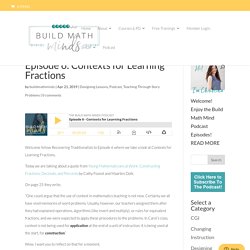

Twitter. Twitter. The Nuances of Understanding a Fraction as a Number. Student work is just the best.

It is the one thing that will always motivate me to write! So, let’s kick this post off with a great work example from 3rd grade. In this task, students are asked to locate 1 on a number line labeled with 0 and 1/3. When I look at student work, I typically think about 3 things: I look for evidence of what the student understands. Before reading on, what do you see in the work? Here are some ideas I think the student understands based on the work: Since the denominators increase from 1 to 5, there is evidence of an understanding that whole numbers increase as they move to the right on the number line. Fractions Learning Pathways: Part 3 - Top 10 Lessons Learned. Are We Teaching Fractions Correctly? When I first started teaching third grade almost 20 years ago, my students and I loved the fraction unit in math!

We all thought it was fun because I could bring in lots of great manipulatives (including food sometimes!) To help my students understand fractions. One year I bought ice cream sandwiches and after my students spent some time cutting them up into various numbers of equal sized pieces, and before the ice cream melted, the students got to eat parts of about 3/4 of the ice cream sandwiches! I learned fractions myself when I was in grade school by working with representations such as pizzas, pies, and cakes. My wife just came up with a fantastic math question. Making cookies, she had already dirtied a 1/3 cup and a 3/4 cup. She managed to get 2 1/2 cups of flour using only those two. How did she do it?
Adina R sur Twitter : "Tried out a #choralcount today to make the connection from fractions to decimals. After the cc we had our introductory discussion about decimals. After that I had students pick numbers from the count to write as decimals. #mtbos @Bu. Are We Teaching Fractions Correctly? Subtracting Mixed Numbers with Regrouping (Using Manipulatives) - Teaching with Jennifer Findley. Subtracting mixed numbers with regrouping can be super tricky for some (or most) students.

There are many ways to teach subtracting mixed numbers with regrouping using manipulatives that may help your students conceptualize the process. On this post, Rachel from You’ve Got This Math will share three of her favorite ways to teach subtracting mixed numbers when borrowing is necessary. Strategy or Luck? Students play the game 'Uncover' to identify equivalent fractions. #FractionsareFun #DotheMath #Closinggaps… Fractions Teaching. Multiplying Fractions and Whole Numbers: Two Types of Problems - Teaching with Jennifer Findley. Confession: I had to relearn 4th and 5th grade math conceptually in order to best teach and support my students.

I learned that when I taught algorithms and tricks without the foundation of a conceptual understanding, it really affected my students’ mathematical understandings and how they solved word problems. When my students didn’t have a conceptual understanding of a mathematical operation, they were not successful at solving word problems that required those operations.
With all that being said, I had to learn this myself (the hard way), and I want to save you time by sharing with you what I had to relearn. Fix It: An Activity for Ordering Fractions. Involving students as creators of problems for others to solve provides an experience for them that’s different from the teacher always being the source of problems.

Also, when students have opportunities to solve their classmates’ problems, I find that they invest in their learning in a different way, often with added interest. And a benefit to teachers is that reviewing the problems that students create is useful for assessing their progress. Why You Need To Stop Saying Improper Fractions - The Recovering Traditionalist. Using The CRA Approach To Teach Fractions - The Recovering Traditionalist. So today, I want to show you an example using fractions to show you how it really deepens their understanding.

What we’re going to take a look at is a game called Race to One. This is a pretty popular game. It’s in a lot of curriculums out there. Teaching Fractions With Understanding - The Recovering Traditionalist. So, when Christina asked me to do a guest vlog here and kind of just share what’s been weighing on my mind, I’ll be honest, it hasn’t really changed much in the past two to three years.

Because my thinking is continuing to evolve around progression. If you’re familiar with me and any of my work, I’ve spent a lot of time here over the last few years really diving into the progression of learning for lots of different domains. Because I think it’s really important in order to know how to move student thinking forward, we need to know where it’s coming from, where it is actually when we’re working in our grade level, and then also where it’s going to. Like the understanding that we’re building in this year, where is that learning going to be in the next few years? Episode 7: Beyond Pizzas & Pies. Welcome fellow Recovering Traditionalists to Episode 7 where we are going to go Beyond Pizzas & Pies.

Today I’m not going to read an insight from the book because the title says it all. Beyond Pizzas & Pies, Grades 3-5: 10 Essential Strategies for Supporting Fraction Sense The title of this book is so powerful because it challenges us to think beyond that common context that we use for fractions: Pizzas & Pies. This is just ONE of many things the authors, Julie McNamara & Meghan Shaughnessy, challenge us to think beyond in this book.
All the concepts that kids struggle with around fractions and even common teaching practices that aren’t developing the best fraction sense for our kiddos are addressed in this book. Episode 6: Contexts for Learning Fractions. Welcome fellow Recovering Traditionalists to Episode 6 where we take a look at Contexts for Learning Fractions.

Today we are talking about a quote from Young Mathematicians at Work: Constructing Fractions, Decimals, and Percents by Cathy Fosnot and Maarten Dolk. On page 25 they write, “One could argue that the use of context in mathematics teaching is not new. Certainly we all have vivid memories of word problems. Usually, however, our teachers assigned them after they had explained operations, algorithms (like invert and multiply), or rules for equivalent fractions, and we were expected to apply these procedures to the problems. Are We Teaching Fractions Correctly? Greg Tang believes simplest is best. Rewriting a x fractions problem by naming it avoids a common error.#R7PD… Fraction Benchmarks.
Monday, I’m meeting with the 2nd grade team to help share some ideas for teaching fractions.

One of their objectives is to determine if fractions are closer to 0, 1/2, or 1. I remembered from last year that this was a particularly difficult skill for the kiddos, even when looking at pictures of the fractions. Sooooo, I have been thinking of a way to help them visualize it better. We have hard plastic fraction tiles, and yesterday I made a number line to scale to the tiles so the kids could lay the tiles beneath the number line. I tried it out, and I was amazed at how it just made the relationships pop! Fractions are Hard! The truth is that fractions are hard! And the reason why is that we are never told what a fraction actually is. First, fractions are “calls to action” – identify a third of the kittens, take a fourth of the pie – and certainly are not quantities we can add or multiply.
(How do you add kittens and pie?) Fractions Teaching. The Importance of Contexts and Visuals. My wife Anne-Marie isn’t always impressed when I talk about mathematics, especially when I ask her to try something out for me, but on occasion I can get her to really think mathematically without her realizing how much math she is actually doing. Here’s a quick story about one of those times, along with some considerations: A while back Anne-Marie and I were preparing lunch for our three children. It was a cold wintery day, so they asked for Lipton Chicken Noodle Soup. If you’ve ever made Lipton Soup before you would know that you add a package of soup mix into 4 cups of water. Typically, my wife would grab the largest of our nesting measuring cups (the one marked 1 cup), filling it four times to get the total required 4 cups, however, on this particular day, the largest cup available was the 3/4 cup.
Here is how the conversation went: Drawing Number Lines to Visualize Equivalent Fractions. Choral Counting: A Lever to Develop Fraction Understanding. Fractions play a prominent role in students’ mathematical understanding and are part of the Major Work of elementary mathematics in grades 3-5. Knowing this, we decided to make fractions the content and context of a professional learning experience for teachers and students called Fraction Lab. You can read more about Fraction Lab here. This professional learning experience included pedagogies of investigation and enactment. When we first began to plan for the experience, we considered the students we would be working with as well as the instructional materials available. From the lens of instructional materials, it was important to us to use high-quality aligned materials in our work with students, materials that would ensure access to the standards. We read the EdReports review for the district-adopted program and examined the fraction units in both third and fourth grades.
The pre-assessment also included two number lines, each with 0 plotted along with one other fraction. Ashley: 7. Choral Counting: A Lever to Develop Fraction Understanding. My Favorite Fraction Manipulative. Wait, that just looks like strips of paper?! Yep, that's what it is. Introducing my FAVORITE fraction manipulative. No need for fancy plastic fraction tiles, no purchase order necessary, no app to download. Just find some paper and cut it in strips. It can even be "GOOSe" paper (good on one side), as in scrap paper! Fractions – Math Visuals. Adding Fourths to Make 1 Unit Fractions Same and Different Counting by Fourths How to use: Count out loud, then ask: What do you notice?
What do you wonder? Check out Jessica Shumway’s excellent books for K-2 and 3-5 number sense routines, specifically the Counting Routines. Using Guiding Questions to Probe Student Understanding. There is a huge shift in mathematics education away from memorizing procedures and toward deeper conceptual understanding. What Neuroscience Can Tell Us About Making Fractions Stick. Topic: The term "improper" fractions. Math Game: Race to 1. Fractions on a Number Line with Cuisenaire Rods - Math Coach's Corner. Professional Learning Through a Fraction Task Progression – Illustrative Mathematics. Teaching mathematics is a continuous cycle of identifying where each student is in their learning trajectory and determining meaningful ways in which to build on their current understandings.
While we often have little control over students’ mathematical experiences before they walk into our classrooms, we do have complete control of our own learning. Understanding the mathematics and its progression for ourselves is one of the most valuable tools in understanding where students are in their thinking and determining ways in which to help each student make sense of the mathematics in a connected, coherent way. Concrete Learning for Equivalent Fractions - Math Coach's Corner. Fractions are such an abstract concept, and kiddos needs lots of concrete and representational (pictorial) experiences to really understand the meaning of a fraction. The Standards...Stairsteps to Success - Math Coach's Corner. As we finish our second wave of state testing, I am reminded how critically important it is that teachers know and teacher their standards for each math concept.
Fraction Benchmarks - Math Coach's Corner. Most Misunderstood Math Standards in Grade 3. When I was asked to continue the series of the Most Misunderstood Standards for grades 3–5, I immediately said yes! After all, the series is a perfect combination of my two most favorite things: math and writing! Over the course of my 18-year career as a teacher and instructional coach, I have had the privilege to learn deeply about the standards, the Shifts, and the mathematical practices from some of the best math educators in the country. Say What You Mean and Mean What You Say – Illustrative Mathematics. By William McCallum In one of our professional development workshops, there is an activity in which the facilitator asks teachers to skip count by 34.
The facilitator records the count, 34, 64, 94, . . . and then asks for patterns they notice in the recording. In a recent workshop, a group of grade 5 teachers noticed that the numerator increased by 3 each time but that the denominator remained unchanged. When the facilitator asked why, they could easily explain the number of pieces were increasing in the numerator, but couldn’t really give an explanation for the denominator other than “it is just always out of 4.” The funny thing is, they weren’t saying “3 out of 4, 6 out of 4, 9 out of 4” when they skip counted.
Fractions on a Number Line with Cuisenaire Rods. Composing and Decomposing Fractions. CCSSM 4.NF.3b reads as follows: Decompose a fraction into a sum of fractions with the same denominator in more than one way, recording each decomposition by an equation. Justify decompositions, e.g., by using a visual fraction model. Developing Fraction Sense.
What Neuroscience Can Tell Us About Making Fractions Stick. Fractions: Units and Equivalence – Illustrative Mathematics. Comparing Fractions: Like Numerators or Denominators. Untangling fractions, ratios, and quotients – Illustrative Mathematics. Illustrative Mathematics. Fraction Division via Rectangles. Struggle with Fractions Webinar. Nctm. Exploring fraction operations with Choral Counts – Getting Sharper Methods. Comparing Fractions: Find a Common Numerator or Denominator. The Importance of Contexts and Visuals. Concrete Learning for Equivalent Fractions. Buildmathminds. Developing Fraction Number Sense Through Part/Whole Thinking. Drawing Number Lines to Visualize Equivalent Fractions. How To Help Every Child Fulfil Their Potential.
Adding Fractions 4.